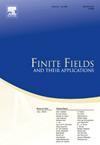New constructions of abelian non-cyclic orbit codes based on parabolic subgroups and tensor products
IF 1.2
3区 数学
Q1 MATHEMATICS
引用次数: 0
Abstract
Orbit codes, as special constant dimension subspace codes, have attracted much attention due to their applications for error correction in random network coding. They arise as orbits of a subspace of under the action of some subgroup of the finite general linear group . The main contribution of this paper is to propose new methods for constructing large non-cyclic orbit codes. First, using the subgroup structure of maximal subgroups of , we propose a new construction of an abelian non-cyclic orbit codes of size with . The proposed code is shown to be a partial spread which in many cases is close to the known maximum-size codes. Next, considering a larger framework, we introduce the notion of tensor product operation for subspace codes and explicitly determine the parameters of such product codes. The parameters of the constructions presented in this paper improve the constructions already obtained in [6] and [7].
基于抛物子群和张量积的阿贝尔非循环轨道码的新构造
轨道码作为一种特殊的常维子空间码,因其在随机网络编码中的纠错应用而备受关注。它们是Fqn的子空间在有限一般线性群GLn(q)的子群作用下的轨道。本文的主要贡献是提出了构造大型非循环轨道码的新方法。首先,利用GLn(q)的极大子群的子群结构,提出了k≤n/2的大小为qk的阿贝尔非循环轨道码的新构造。所建议的代码显示为部分扩展,在许多情况下接近已知的最大码长。其次,考虑到一个更大的框架,我们引入了子空间码的张量积运算的概念,并明确地确定了这些积码的参数。本文给出的结构参数是对[6]和[7]中已有结构的改进。
本文章由计算机程序翻译,如有差异,请以英文原文为准。
求助全文
约1分钟内获得全文
求助全文
来源期刊
CiteScore
2.00
自引率
20.00%
发文量
133
审稿时长
6-12 weeks
期刊介绍:
Finite Fields and Their Applications is a peer-reviewed technical journal publishing papers in finite field theory as well as in applications of finite fields. As a result of applications in a wide variety of areas, finite fields are increasingly important in several areas of mathematics, including linear and abstract algebra, number theory and algebraic geometry, as well as in computer science, statistics, information theory, and engineering.
For cohesion, and because so many applications rely on various theoretical properties of finite fields, it is essential that there be a core of high-quality papers on theoretical aspects. In addition, since much of the vitality of the area comes from computational problems, the journal publishes papers on computational aspects of finite fields as well as on algorithms and complexity of finite field-related methods.
The journal also publishes papers in various applications including, but not limited to, algebraic coding theory, cryptology, combinatorial design theory, pseudorandom number generation, and linear recurring sequences. There are other areas of application to be included, but the important point is that finite fields play a nontrivial role in the theory, application, or algorithm.

 求助内容:
求助内容: 应助结果提醒方式:
应助结果提醒方式:


